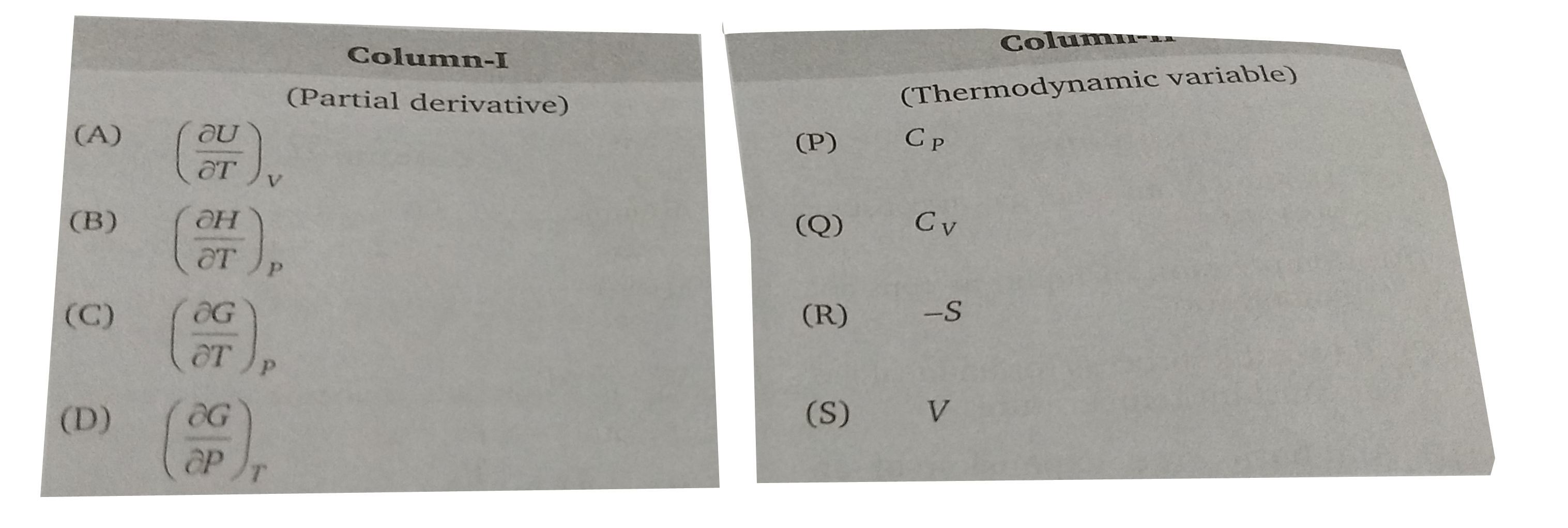Out of internal energy (I), boiling point (II), pH (III) and E.M.F. of the cell (IV) intensive properties are :Solution in Punjabi
I, II
II, III, IV
I, III, IV
All of these
The correct Answer is:B
Boiling point, pH and emf are intensive property.
Topper's Solved these Questions
- BOOK - NARENDRA AWASTHICHAPTER - THERMODYNAMICSEXERCISE - Level 3 - One Or More Answers Are Correct1videos
THERMODYNAMICS
- BOOK - NARENDRA AWASTHICHAPTER - THERMODYNAMICSEXERCISE - Level 3 - Match The Column2videos
THERMODYNAMICS
- BOOK - NARENDRA AWASTHICHAPTER - THERMODYNAMICSEXERCISE - Level 2 (Q.1 To Q.30)1videos
THERMODYNAMICS
- BOOK - NARENDRA AWASTHICHAPTER - STOICHIOMETRYEXERCISE - Level 3 - Subjective Problems20videos
STOICHIOMETRY
Similar Questions
Assume ideal gas behaviour for all the gases considered and neglect vibrational degrees of freedom. Separate equimolar sample. Separate equimolar samples of Ne, O2 , CO2 and SO2 were subjected to a two process as mentioned. Initially all are at same state of temperature and pressue.
Step I → All undergo reversible adiabatic expansion to attain same final volume, which is double the original volume thereby causing the decreases in their temperature.
Step → After step I all are given appropriate amount of heat isochorically to restore the original temperature.
Mark the correct option(s) :02:18View SolutionMatch the following columns
 02:46View Solution
02:46View SolutionWrite structure of 2,2-dimethylheptane.
02:14View SolutionWhat volume of a liquid (in L) will contain 10 mole ? If molar mass of liquid is 280 and its density is 1.4 g/mL.
View SolutionOut of boiling point (P), entropy (Q), pH (R ) and e.m.f. of cell (S), intensive properties are:
01:08View SolutionWhich of the following are intensive properties?
Boiling point
Melting point
Heat capacity
Volume
Enthalpy
Mass
Internal energy
Molar volume08:51View SolutionOut of internal energy (I), boiling point (II), pH (III) and E.M.F. of the cell (IV) intensive properties are :
07:15View SolutionOut of boiling pont (I), entropy (II), pH (III) and density (IV), Intensive properties are :
08:18View SolutionOut of boiling point (I), entropy (II), pH (III) and e.m.f of a cell (IV), intensive properties are:
08:18View Solutionउत्कृष्ट गैसों के सन्दर्भ में निम्नलिखित गुणधर्मों का वर्णन कीजिए-
(i) रासायनिक क्रियाशीलता (ii) परमाणुकता
(iii) परमाणु त्रिज्या (iv) गलनांक तथा क्वथनांक
(v) आयनन ऊर्जा (vi) जल में विलेयता
(vii) द्रवीकृत होने की प्रवृत्ति।07:08View Solutionसंक्रमण तत्त्वों के निम्नलिखित गुणों की व्याख्या कीजिए-
(i) गलनांक तथा क्वथनांक (ii) आयनन ऊर्जा (iii) ऑक्सीकरण अवस्थाएँ (iv) चुम्बकीय व्यवहार (v) आयनों के रंग।View Solutionनाइट्रोजन परिवार के हाइडाइड्रो को निम्न बिन्दुओं के अन्तगर्त समझाइए-
(i) नाम व सूत्र, (ii) क्षारीय गुण (iii) अपचायक गुण (iv) बंध कोण, (v) गलनांक एवं क्वाथनांक ।06:28View Solutionनाइट्रोजन परिवार के हाइड्राइडो का निम्न बिन्दुओं पर वर्णन कीजिए -
(i) नाम व सूत्र , (ii) क्षारीय गुण , (iii) अपचायक गुण ,(iv) बंध कोण , (v) गलनांक एवं क्वथनांक ।View SolutionExplain with examples: (i) enthalpy of a system is an extensive property (ii) boiling point of a liquid is an intensive property (c) concentration is an intensive property.
View SolutionOut of boiling point (I), entropy (II), pH (III) and density (IV), Intensive properties are :
02:41View SolutionWhat is liquid state of matter ? Discuss the following properties of liquids?
(i) Evaporation(ii) Boiling point(iii) Viscosity(iv) Surface tension.05:25View Solution

